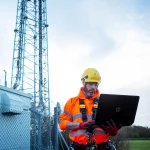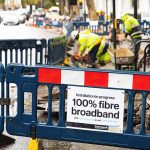BT Cut 13K Jobs, Raise £3.7bn to Boost FTTP Broadband and Mobile UPDATE
BT has released their Q1 2018 (calendar) results, which sees them increase FTTP and Mobile infrastructure investment via an annual capex allocation of around £3.7bn (excluding BDUK) and report that 1.56 million UK premises are now covered by their G.fast and FTTP based “ultrafast broadband” (100Mbps+).
Broadly speaking the first quarter of 2018 has been fairly quiet, assuming you can ignore the on-going battle between the operator and regulator / Government to extract a wider roll-out of FTTP “full fibre” broadband (here). Meanwhile Ofcom decided not to impose a temporary Dark Fibre Access remedy on Openreach, but they did pledge to try again next March (here), and BT also reached a crucial pensions deal (here).
Otherwise the embattled operator initially seemed to be having a good quarter after their mobile division (EE) grabbed 40MHz of the 5G friendly 3.4GHz band (here). Elsewhere they also announced plans to create 1,300 new UK apprenticeship / graduate Jobs (here) and started to hire another 3,500 Openreach engineers (here).
Advertisement
Unfortunately all of that must now be tempered against today’s decision to axe 13,000 jobs over the next three years (mainly back office and middle management roles), although they will mitigate some of that by hiring around 6,000 new employees to support network deployment and customer service. This is expected to achieve a year 3 cash cost reduction of £1.5 billion with costs to achieve of £800 million and two year payback.
At the same time BT will boost investment in FTTP and their language now sounds like more of a target than an aspiration: “In fixed, Openreach is taking a ‘Fibre First’ approach that positions the business to deliver, economically, at scale and pace, 10 million fibre-to-the-premises, FTTP, by the mid-2020’s, while in mobile, BT will continue to build 4G to 95% geographic coverage by 2020 and intends to lead the market in 5G.”
Financial Highlights – BT’s Quarterly Change
* BT Group quarterly revenue = £5,967m (down from £5,970m)
* BT Group reported profits before tax = £872m (up from £660m)
* BT Group total net debt = £9,627m (up from £8,923m)
* BT Wholesale quarterly operating profit = £126m (up from £110m)
* Openreach quarterly operating profit = £307m (up from £305m)
* Openreach quarterly capital expenditure = £394m (down from £477m)
As usual BT has included an update on their capital expenditure and clawback (gainshare) from the government’s Broadband Delivery UK roll-out programme (i.e. public investment returned by BT due to rising take-up in FTTC/P covered areas), which reveals that £536m (up from £527m last quarter) of public funding may potentially become available for reinvestment into further UK coverage of “fibre broadband” services.
In addition, BT said that their base-case assumption for take-up in BDUK areas had risen slightly to 41% of total homes passed (up from 40% last quarter). The Government intends to use this reinvestment to help push the coverage of “superfast broadband” to approximately 98% of UK premises by around 2020 (here).
Advertisement
BT Consumer / Retail
The retail side of BT’s broadband ISP business holds the single largest share of “fibre broadband” (FTTC/P/G.fast) subscriptions on Openreach’s national UK network, which saw them add 202,000 customers in the quarter (down from 208K last quarter) to total 5.713 million on fibre based lines.
Not to mention that BT also remains the largest consumer broadband ISP in the whole of the UK by quite a wide margin with an overall total of 9,339,000 customers (ADSL, Fibre etc.), although that’s actually a quarterly drop of -3,000 (compared with +35,000 in the previous quarter) and this fall is partly due to a 5k base adjustment following review.
Meanwhile BT / EE’s mobile base continues to shrink (down by a staggering -204,000!) and curiously their 4G subscribers have remained flat on 19.6 million. We also note that BT’s Pay TV (IPTV) base has continued to decline by -13,000 in the quarter. Not good news.
| Broadband Subs | TV Subs | Mobile Subs + EE |
Fibre Subs | |
| Q1 2018 TOTAL |
9,339,000 | 1,738,000 | 29,558,000 | 5,713,000 |
| Q1 Change | -3,000 | -16,000 | -204,000 | +202,000 |
| Q4 2017 TOTAL |
9,342,000 | 1,760,000 | 29,762,000 | 5,492,000 |
| Q4 Change | +35,000 | -5,000 | +40,000 | +208,000 |
On top of all that BT also reported that EE’s geographic (landmass) 4G network coverage of the United Kingdom remains at 90% (the same as last quarter), although they still aim to cover 95% by the end of December 2020.
Advertisement
Openreach & Wholesale
Openreach’s national telecoms and broadband network serves various ISPs across the United Kingdom, including BT itself and various others like Sky Broadband, TalkTalk etc. (i.e. the total broadband and “fibre” lines listed below combine active customers from BT’s own service as well as many other ISPs).
It’s worth noting that the quarterly increase of +555,000 in new “fibre broadband” (FTTC/P) lines below also includes the +202,000 added via BT’s own ISP. In other words, BT’s rivals accounted for +353,000 of the total increase (down from +392,000 last quarter). Separately, BTWholesale delivered a total of just 849,000 external broadband lines for other ISPs, which is down by -14,000 in the quarter.
| Total UK Broadband Lines (ADSL, Fibre) |
Fibre Lines (FTTC / FTTP / G.fast) |
|
| Q1 2018 TOTAL |
20,746,000 | 9,796,000 |
| Q1 Change | +100,000 | +555,000 |
| Q4 2017 TOTAL |
20,645,000 | 9,241,000 |
| Q4 Change | +157,000 | +600,000 |
At present the operator’s “fibre” based network covers 27.6 million UK premises (up from 27.4m in the last quarter) and the majority of those are reached via their slower ‘up to’ 80Mbps capable Fibre-to-the-Cabinet (FTTC / VDSL2) services. Plus 1.56 million of the total can also now access their FTTP or G.fast based “ultrafast broadband” (100Mbps+) connections, which is up from 886,000 last quarter.
We should add clarify that Openreach claims to have now covered 1 million premises with their new 330Mbps capable hybrid fibre G.fast technology (expected to reach 10 million premises by 2020), while they report that 560,000 can access their “full fibre” FTTP network (expected to reach 3 million premises by 2020 and then 10 million by around 2025). It’s not clear if these are all live services that can actually be ordered.
Gavin Patterson, CEO of BT Group, said:
“BT delivered a solid set of financial results in the fourth quarter, with growth in our consumer divisions offset by declines in our enterprise businesses, due to both challenging market conditions and our decision to exit lower margin business.
We continue to invest for growth, having now passed 1.5m premises with our ultrafast network and securing 40MHz of 3.4GHz spectrum suitable for 5G mobile services. We are improving our customer experience across the Group, with our key metrics of Group NPS1 and Right First Time2 both strongly up.
Our integration and restructuring activities remain on track. The integration of EE into BT is delivering run rate cost synergies of £290m. Our restructuring programme has removed over 2,800 roles and delivered savings of £180m during the year.
I am pleased that we have reached agreement with the Trustee on the pension valuation and recovery plan, which is affordable within our capital allocation framework, and draws a line under a key source of uncertainty for our stakeholders.
We have announced today an update to our strategy to accelerate leadership in converged connectivity and services. Our strategy will drive sustainable growth in value by focusing on delivering differentiated customer experiences, investing in integrated network leadership, and transforming our operating model.”
Overall BT’s consumer figures have suffered somewhat of a dip during the first three months of 2018, while today’s news of job cuts and more investment for FTTP / mobile is a mixed bag. The operator has also published a new Strategy that talks about their aim to have a “single integrated all-IP fibre network” that enables seamless converged access across fixed, WiFi and mobile “whilst maintaining capital expenditure discipline within an annual allocation of around £3.7 billion over the next two years.”
In the Consumer business, BT added that they will launch a new range of converged fixed and mobile products (i.e. to support customer retention, increase loyalty and improve economic returns) and make better use of customer data and digital channels for “more targeted and personalised marketing.” At present we don’t know precisely what this will result in but with EE alongside they could easily do some clever quad-play packages.
One big challenge here is that bundling appears to have lost some of its magic in recent years, with traditional Pay TV being eroded by the streaming giants and many consumers still preferring to keep their Mobile plans separate from fixed line services.
UPDATE 4:51pm
Today there was an investor chat with some of BT’s top people (mostly involving CEO Gavin Patterson) and we noted a few comments that might help to add some context to the above news. We’ve summarised these below.
Broadband Related Investor Quotes from BT
— We saw a further 4% reduction in copper network faults.
— We are receiving good feedback on our commercial deployments of Gfast, and we will continue to use this technology in non-FTTP areas to maintain a competitive position in the near term.
— Our longer-term aim is to deliver an ultrafast, all-IP future, which we will deliver, moving from 11 primary access points to just 3, from 5,600 exchanges with multiple setups to just 1,100 fiber points of handover. And from a world where today a physical engineering intervention is required for 90% of customers’ moves or changes to a near zero touch network standardized exchanges that are primarily software managed. This will allow us to lead the market in single order products, lower network faults, deliver real-time provisioning, and allow us to close the end-of-life PSTN telephone network by the mid-2020s. And will of course provide further opportunity to help us improve efficiency.
— So, if there’s a change of emphasis today, it is not about the 3 million versus the 10 million per se. We continue to be focused on getting to 10 million. We’re sure about the 3 million. What I would like to sort of emphasize is I think I’m feeling increasingly confident that actually we’re going to get the right set of conditions to be able to make a return on it, and that’s got to be good for shareholders.
We understand how to get the unit efficiencies for cost per home passed. And I can tell you, we’re very encouraged by the early signs of that. So, all in all, what I’m saying to you is we’ve got increased confidence that we’ll get to the 10 million. It’s not a sure thing yet but we’re going to make sure we do absolutely everything we can do that and make a good return on top of it.
— So, news flow on FTTH. What you’ll get from us is a update every quarter on how we are building that network, and Clive will give you color on how it’s going as he delivers it across the whole of the UK. We’ll talk also about the take-up and the types of propositions that we’re offering to consumers and businesses, but we’re getting on and doing it.
Mark is a professional technology writer, IT consultant and computer engineer from Dorset (England), he also founded ISPreview in 1999 and enjoys analysing the latest telecoms and broadband developments. Find me on X (Twitter), Mastodon, Facebook, BlueSky, Threads.net and Linkedin.
« North Yorkshire UK Publish FTTP Ultrafast Broadband Rollout Plan

















































Comments are closed